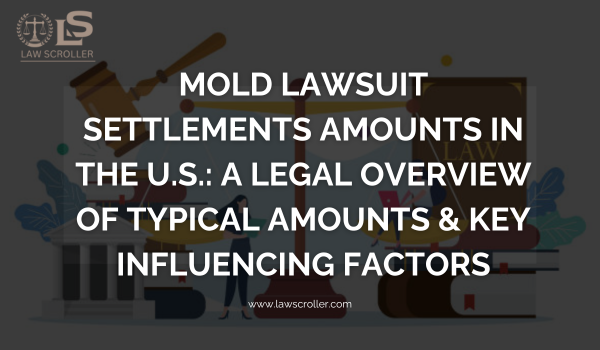When individuals or groups pursue legal action over mold exposure—whether in homes, workplaces, rental properties or commercial buildings—the resulting settlements can vary tremendously. This article provides a U.S.-law perspective on how much mold‐related lawsuits have settled for, what drives the number, and what potential claimants should understand.

Settlement Ranges: What the Data Shows
While there is no comprehensive public database of all mold‐exposure lawsuit settlements, available sources provide helpful ranges and highlighted case results.
- One summary source lists “minor cases” with perhaps US$5,000-20,000, “moderate cases” US$20,000-100,000, and “severe cases” (long‐term health complications or large property losses) at US$100,000 or more.
- A law-firm blog reports specific larger outcomes:
- A jury verdict of US$1,200,000 for a woman exposed to mold in her condo when the homeowners association failed to fix water leaks.
- A high‐profile case, Ballard v. Farmers Insurance Group (Texas, 2001) allegedly produced a settlement of US$32 million (later reduced to US$4 million on appeal) in a severe mold/insurance‐bad-faith scenario.
- Specific smaller settlements:
- A landlord/tenant mold case in San Diego settled for US$500,000.
- Another in California settled at US$150,000 for mold‐related asthma injuries.
- On the larger spectrum, some complex property‐related or multi‐tenant cases (especially class actions) have settlement totals in the multi‐million dollar range. For instance, one listing shows class‐action settlements of US$12.25 million and US$18.75 million in Connecticut housing/mold cases.
In short: many mold‐exposure lawsuits settle for figures in the low‐six‐figure range, but high‐value cases (especially those involving many claimants, serious health injury, long exposure, or large property damage) can reach millions.
What Drives the Settlement Amounts?
Several legal and factual factors heavily influence how large (or small) a settlement will be in a mold lawsuit:
- Severity and nature of health injury:
If exposure is alleged to have caused chronic respiratory disease (asthma, lung infection), neurological or allergic damage, or other long‐term effects, the claim has greater value. Conversely, limited short‐term complaints will command less. - Extent of property damage and remediation costs:
If the mold growth required major structural repair (walls, ceilings, HVAC, mold remediation) or replacement of personal property, the damage side of the claim increases. - Duration of exposure and persistence of condition:
Longer exposure and more delayed discovery often increase value because the potential ongoing harm or loss of health/earnings is greater. - Proof of negligence or knowledge by the defendant:
Cases where the property‐owner, landlord, builder or insurer knew (or reasonably should have known) about the mold risk, ignored repair requests, or failed to act constitute stronger claims and can lead to larger settlements. - Number of claimants / class action vs individual:
When many tenants or homeowners are affected (multi-unit housing, condo development) the aggregate amount rises and defendants may settle for larger sums to resolve broadly. Class‐action style or mass‐tenant claims often achieve multi-million totals. - Location / jurisdiction / applicable law:
Different states have varying laws about landlord liability, property conditions, statute of limitations, and damages caps. This variation influences outcomes.
Key Legal Considerations for Claimants
If you believe you may have a mold claim, here are important legal points:
- Act promptly: Statute of limitations may limit the time you can file. Delay in discovery can affect when the clock starts.
- Document thoroughly: Medical records linking health issues to exposure, environmental tests or expert reports showing mold presence or leaks, repair requests to landlord/builder, and photos of damage all strengthen the case.
- Establish causation: Proving the mold caused the injury (not some other factor) is essential. Expert testimony is often required.
- Ensure your damages are quantified: Health‐care costs, lost wages, property repair, diminution of value–these need to be documented.
- Choose the right defendant(s): Landlord, property manager, building contractor, insurer—who had duty and failed?
- Consider settlement vs trial: Many cases settle out of court. A large settlement may be more assured than a riskier trial verdict.
- Attorney fees: Usually contingency-based in personal injury/environmental cases, but make sure you understand fee structure and costs.
- Class/tenant mass claims may differ: If you are part of a multi‐tenant claim, your individual payout may be smaller compared to ego-settlement dollars.
Why Larger Settlements Are Rare
While some mold cases reach millions, many claimants receive far less. Reasons include:
- Difficulty proving long‐term injury causation specifically caused by mold (versus genetics, allergies, other exposures).
- Many cases are property‐damage only (no serious health injury) which often limits damage to repair/remediation rather than personal injury.
- Settlements may be confidential so published results tend to reflect the larger “headline” cases, not the many smaller ones.
- Defendants may settle early for modest amounts rather than risk a large trial verdict but likewise may not pay very high amounts unless risk is substantial.
Conclusion
In the U.S., mold‐exposure lawsuit settlements span a wide range—from tens of thousands of dollars in simpler cases, to hundreds of thousands in moderate personal‐injury/property-damage claims, and into multi-million dollars when serious health injuries, large‐scale property damage, and multiple claimants are involved. For example, basic summaries put “better” mold cases at over US$100,000, while specific examples show settlements of US$500,000 and higher, and even US$12-35 million in larger aggregated matters.
If you believe you’ve been harmed by mold exposure, the key legal takeaway is that your case will be evaluated on its individual facts: health outcome, damage magnitude, defendant conduct, your documentation, and jurisdictional rules. A discussion with an experienced attorney can help you assess your potential claim value, likely settlement range, and whether pursuing the case is feasible.


 Oliver Johnson is LawScroller’s Senior Legal Correspondent specializing in civil litigation, class actions, and consumer lawsuit coverage. He breaks down complex settlements and court decisions into clear, practical guidance for readers.
Oliver Johnson is LawScroller’s Senior Legal Correspondent specializing in civil litigation, class actions, and consumer lawsuit coverage. He breaks down complex settlements and court decisions into clear, practical guidance for readers.